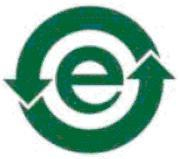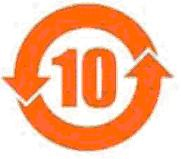90 days and counting. Will you be ready for China RoHS?
China RoHS will impose marking/declaration requirements and substance restrictions on Electronic Information Products (EIP) beginning March 1, 2007. A delegation of officials from the Chinese Ministry of Information Industry (MII) presented at an AeA organized China RoHS seminar in Santa Clara, CA on October 26, 2006 to discuss the upcoming regulations.
About 200 attendees from electronics OEMs and manufacturers across North America attended the half-day event. The level of confusion and uncertainty surrounding China RoHS is evident with the 300 questions that were submitted to the MII delegation during their presentations. Many of the questions were similar and only a few of the questions could be answered in the time available.
The presentations generally did not provide enough detail about all the requirements of China RoHS, but several important subtleties in the implementation of the regulations did emerge. The presentations provided a glimpse into the methods behind Chinese rule making and what could be expected from China RoHS over the next few years. Note: Some of the information presented by the officials and appearing in this column are preliminary and are still subject to change.
China RoHS is applicable to EIP as defined in Article 3 of the Management Methods and as per the "explanatory note" published March 16, 2006, with the intention to eventually include all electronic products. The explanatory note currently lists over 30 pages of products.
Substance restrictions are with regard to the same six hazardous substances identified in the EU RoHS Directive: lead, cadmium, mercury, hexavalent chromium, PBB and PBDE (excluding Deca-BDE). The substance restrictions and pre-market testing are only applicable once the product has been added to the key catalogue. Products will be copied from the EIP list to the key catalogue over time.
Wang Bingke, the Deputy Director General of the Department of Economy Reform and Economic Operations, MII provided opening remarks stating that China has become the workhorse of the electronics industry. He confirmed that the management measures would come into force on March 1, 2007 and stated that the MII is not open to negotiation on China RoHS. However, MII is open to discussing operational challenges and ideas in helping to define the specific implementation details.
Overview of China RoHS
China RoHS is to be implemented using three pillars:
- Management methods (legislation)
- Standards
- Key catalogue
It was pointed out that there are significant differences between the European and Chinese approaches. China does not have technical legislation that allows it to follow the approach used by the EU with regard to exemptions, exclusions and other technical elements. Conversely, the EU directive does not directly utilize standards, whereas, for China, standards are the accepted method and means of implementation.
The presenters identified four parts (key requirements) of the China RoHS regulation related to enterprises:
- EIPs should be designed and manufactured for easy recycling and for environmental friendliness.
- Declaration of hazardous substance name, concentration, environmental-friendly uses period, recyclability should be made.
- Products added to the key catalogue will be banned from using hazardous substances.
- China Compulsory Certification (CCC) enforcement.
Manufacturers and importers of EIP products must comply with all articles except article 18, 19, 20 and 20 as of March 1, 2007. All EIPs must be labeled. The scope of China RoHS does not apply to export products and military products.
Products in the key catalogue must comply with all articles, including substance restrictions. Products are put into the catalogue when technology is ready to allow substitution of hazardous substances. They must have both self-declaration and CCC certification.
China adopted the key catalogue approach to reflect a principle of step-by-step inclusion - only those products for which substitution of hazardous substances is possible would be added to the key catalogue. MII points out that this is opposite to the EU RoHS approach of exclusions and exemptions. The catalogue methodology was decided upon to decrease resistance from enterprises.
The initial focus on standards has been concentration limits, marking and testing (disassembly), and are expected to be published fairly soon. Secondary standards that are still in development include: chemical component of lead-free soldering, electronic grade Sn alloy powder, electronic grade Sn solder paste, water-based solder flux with washing and lead-free solder experiment method.
The standard working group for China RoHS has 102 members, organized into five subgroups. The standards for China RoHS are divided into nine parts that regulate the marking for environmental protection use period, hazardous substances or elements, recover ability and packaging material's name.
EIPs must be marked with one of two logos. Logo 1 (see Figure 1) is used for products that have no hazardous substances (as per the maximum concentration value standard). Logo 2 (see Figure 2) must be used for EIPs that contains hazardous substances above the maximum thresholds. In the center of Logo 2 is a number representing the Environmental Protection Use Period (EPUP).
|

FIGURE 1. Logo 1.
|
|

FIGURE 2. Logo 2.
|
Products used in the supply chain for manufacturing into end products do not need to be labeled. However, manufacturers of these parts must provide information to the manufacturer of the end product for incorporation into the final product label and hazardous substance declaration table.
The label must be applied to the surface of products when the product has a regular surface area greater than 5,000mm2. For surfaces less than that, or that are irregular in shape, the label may be contained in the manual book. Function and "beauty factors" may be taken into consideration in determining the location of the symbol.
In addition to the EPUP marking, a table of hazardous substances' names and concentration is to be provided in the product manual. For each part in the EIP (identified by component name), the table must indicate for each of the six hazardous substances, whether it is present above the maximum concentration value (marked with an "X") or absent (marked with a "O"). The table must be in Chinese. It was also noted that if a component/part has none of the six hazardous substances, the component does not need to be listed in the declaration table.
Package marking is required as part of China RoHS and must follow China standard GB 18455-2001. The marking focuses on the packing materials used in order to assist in initial sorting for recovery.
Unlike EU RoHS, China RoHS has defined maximum concentration values (MCVs) based on composition units that are more practical for testing. Three composition units have been defined:
- Homogeneous Materials (EIP-A)
- <1000ppm for Pb, Hg, Cr+6, PBB, PBDE (excluding Deca-BDE)
- <100ppm for Cd
- Metal plated parts (EIP-B)
- Pb, Hg, Cr+6, Cd cannot be intentionally used.
- Small components <= 1.2mm3 (0805 component) (EIP-C)
- Cannot be separated in homogeneous materials under current conditions
- <1000ppm for Pb, Hg, Cr+6, PBB, PBDE (excluding Deca-BDE)
- <100ppm for Cd
If composition of each EIP unit meets the requirements above, the EIP conforms to the China RoHS Standards; otherwise it does not conform.
The proposed test methods standard suggests screening EIP for hazardous substances with X-ray fluoroscopy first. If screening is inconclusive, chemical testing may be required. For chemical analysis testing, the China RoHS standard will define test methods for each restricted substance, similar to the approach used in the current draft of IEC 62321.
Q&A
Question: What does the March 1 date mean? Is it the date of manufacturing or date of sales?
Deputy Director General Wang indicated that March 1, 2007 is the "enforcement date"; the date that the regulation becomes legally binding. It involves the manufacturers, who must be compliant, and the consumers, who must take appropriate measures for ensuring that they are purchasing products that are as environmentally friendly as possible and ensuring that those products are recycled at end of life. There may be some remedial measures introduced for products that are manufactured before March 1, 2007 and not in compliance.
Question: Are spare parts to be labeled?
Spare parts (used for direct repair) need not be marked. However, spare parts that are sold independently must be treated as products and marked.
There were also several questions requesting clarification for products that are not clearly on the EIP list. The response was that many products might fall into the "others" subcategories, which appear throughout the list. MII is trying to amend and update the list for better definition and clarity. As specific product types are added to the key catalog, they will be pulled out of the "others" category and listed separately. PCD&M
Walter Jager is vice president of engineering at Ageus Solutions. He can be reached at This email address is being protected from spambots. You need JavaScript enabled to view it..













